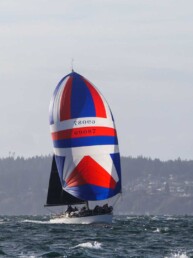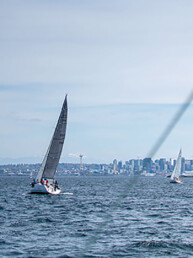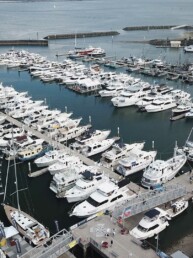This article was originally published in the September 2021 issue of 48° North.
Every year of my childhood, without fail, my parents tried to sign me up for a new sport or group activity — when I was far happier exploring the fields and orchards near our subdivision on my own. That probably explains my reluctance as an adult to commit to organized activities during my free time. It also accounts for my tepid reaction when my friend Andy suggested we participate in the Salish 100, a five day, small-boat cruise from Olympia to Port Townsend. It sounded potentially exasperating: a gaggle of boats getting in each other’s way, inexperienced sailors who could become a liability, and a mess of tangled rodes at the anchorages.
“I did it in 2019, and it was a kick,” Andy said. I normally trust his judgment on the water, and as Covid seemingly waned, I yearned to do something less isolating than solo sailing; so I consented to come along. But only if Andy agreed to head down Hood Canal with me afterwards, to try to loop Puget Sound. That would be my chance, I figured, to decompress from the event and to go someplace I’d never been before.
When the Salish 100 fleet gathered at Henderson Inlet on the first evening of the cruise, I was pleasantly surprised to note that the group was actually hard to find. Like smoke dissipating from a campfire, small clusters of boats had rafted up here and there, or tied to a welcoming dock, but at no point was there any sort of crowd. A few other modest double enders pulled up on the beach at Woodard Bay Conservation Area, along with Andy’s and mine, and we stood wading in the shallows, chatting and listening to thousands of nesting cormorants. Maybe this won’t be so bad, after all, I thought.
Morning two dawned with low clouds and a gentle breeze out of the south. Some boats were still at anchor, cockpit tents sealed, but I was itching to go. I hoisted sail and ghosted through the anchorage, slowly heading north towards Penrose Point State Park. Dutifully, I turned on my VHF radio and listened to the fleet chatter about the logistics of the day. As sailors departed, they’d radio to the crew of Riptide, a 47-foot bridge-deck cruiser and our lead support boat. A woman’s calm, welcoming voice greeted each captain, wishing them a safe voyage.
 The wind petered out near Devil’s Head’s dramatic bluff, and I dropped sail to observe sea creatures as I rowed through the sandy shallows. The ebb current pulled me north through the narrows at Pitt Passage, where a pod of other boats approached. As the wind filled in, I set sail again. But I was puzzled to notice that many participants were now motor sailing, despite a pleasant breeze. Savoring the wind, I took my time, making a wider course and trying to avoid potential tangles as the fleet piled into the Lakebay Marina for burgers and drinks. I wandered around, talking to folks and enjoying their sea stories. Why had so many folks motored, I wondered, when there was a fine breeze? To get a space at the dock, came the earnest answer.
The wind petered out near Devil’s Head’s dramatic bluff, and I dropped sail to observe sea creatures as I rowed through the sandy shallows. The ebb current pulled me north through the narrows at Pitt Passage, where a pod of other boats approached. As the wind filled in, I set sail again. But I was puzzled to notice that many participants were now motor sailing, despite a pleasant breeze. Savoring the wind, I took my time, making a wider course and trying to avoid potential tangles as the fleet piled into the Lakebay Marina for burgers and drinks. I wandered around, talking to folks and enjoying their sea stories. Why had so many folks motored, I wondered, when there was a fine breeze? To get a space at the dock, came the earnest answer.
As I lounged on the state park beach with Andy that day, it became clear that our fleet consisted of several tribes: some who clustered at the dock, others more comfortable in the deeper water, and those happiest nudged up on the beach.
On our third day, the fleet headed northward to Gig Harbor, a place I associate more with yachts than trailer sailors. Still, I was excited about going through the Tacoma Narrows, with the potential for challenging conditions. Late that morning, I found myself entering the Narrows with what I recognized as my own particular tribe — the boats without motors, and those with auxiliary power but helmed by like-minded souls who sailed as much as possible before turning on their iron mizzens. A four-knot current aided us as the Narrows Bridge towered above, inspiring excitement and awe. As we paused at Gig Harbor’s tiny entrance, a mega-yacht towing a thirty-foot tender emerged, dwarfing our humble craft. Many of our group rafted up at the public dock in the center of town, engaging in happy storytelling and sharing drinks around the cockpit. After a victory lap through the anchorage, Andy and I found a surprisingly quiet corner of the harbor near the commercial fishing fleet, content in opting for peace in such a bustling place.
The next few days followed a similar pattern: low clouds, consistent southerly winds, and incessant chatter on the VHF, followed by sunny skies and the fleet underway solely under wind power. During a normal cruise, I might spot one or two other small boats on the water, each sighting engendering a quiet sense of solidarity; but cruising among 80 colorful sails spread out over a few miles was simply joyful. Whether I sailed near a stubby SCAMP, a sleek Ranger 20, or an electric tug, everyone waved and smiled. During conversations at our destination each afternoon, I asked several people what influenced them to participate, and each answer was as unique as the sailor: There are no tides in Montana. I’ve never been on saltwater before. This is the first time I’ve ever done a cruise in a small boat. I wanted the safety that a group provided. Just to see if I could do it.
A laid back afternoon and evening at Blake Island on the fourth day was followed by a stop at Port Ludlow, where a surprise BBQ was announced. The whole fleet gathered in a billowing party tent at a resort where, amid the tremendous din of laughter and merriment, we sang a silly Salish 100 song, toasted our support boats, and ate lots of food. Later, as I drifted back to my boat, I realized that, although initially I hadn’t been excited about coming, the organizers from the Northwest Maritime Center and the other participants had made me feel sincerely welcome. And those new sailors I’d met had become an integral part of the journey—folks I recognized as future friends.
Here at Port Ludlow, Andy and I had intended to peel off from the fleet and head south on our next adventure into Hood Canal. But those consistent south winds, which had enabled us to travel nearly 90 miles with barely a tack, now became
a challenge. Did we really want to continue beating by upwind for days on end to complete our loop? When it came down to it, we did not.
Any regret at abandoning the original plan was balanced by a desire to rejoin our new pals and complete the Salish 100 with them. Turning north, we found our own little four-boat tribe and cruised happily with them towards the finish line, our positions measured only by our satisfaction with the journey.
Bruce Bateau
Bruce Bateau sails and rows traditional boats with a modern twist in Portland, Ore. His stories and adventures can be found at www.terrapintales.wordpress.com






